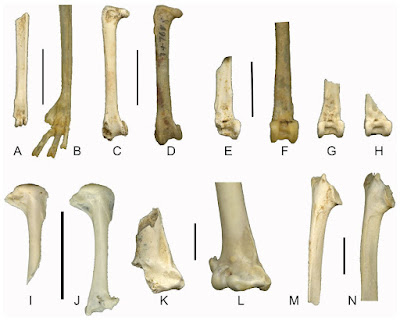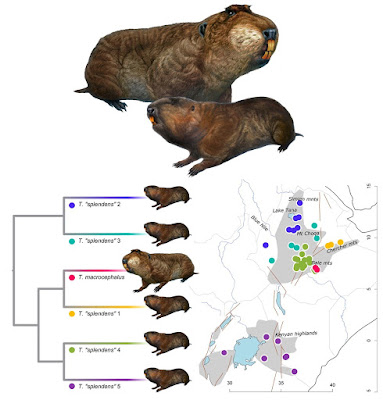 |
| Xibalbaonyx oviceps Stinnesbeck, Frey, Olguín, Stinnesbeck, Zell, Mallison, González, Núñez, Morlet, Mata, Sanvicente, Hering & Sandoval, 2017. DOI: 10.1007/s12542-017-0349-5 |
Abstract
Here we describe a new genus and species of giant ground sloth, Xibalbaonyx oviceps (Megalonychidae, Xenarthra), from the drowned cave system of the northeastern Yucatán Peninsula. The specimen is Late Pleistocene in age and was discovered in the Zapote sinkhole (cenote) near Puerto Morelos in the Mexican state of Quintana Roo. Xibalbaonyx oviceps differs significantly from all hitherto known Megalonychidae including those from the Greater Antilles and South America. The new taxon suggests a local Caribbean radiation of ground sloths during the Late Pleistocene, which is consistent with the dispersal of the group along a Mexican corridor.
Keywords: Ground sloths, Pleistocene, Yucatán Peninsula, Mexico
Systematic palaeontology
Superorder Xenarthra Cope, 1889
Order Pilosa Flower, 1883
Superfamily Megatherioidea Gray, 1821
Family Megalonychidae Gervais, 1855
Diagnosis of the family. Xibalbaonyx oviceps is identified as a member of Megalonychidae based on the following features: dorsal contour of skull evenly convex in lateral view. The glenoid fossa is mediolaterally widened, its posterior surface smooth and the fossa is well separated from the porus acusticus. The lateral plate of the entotympanic is thin with a medial expansion and weak participation in the floor of the tympanic cavity. The paroccipital process is well developed (Patterson et al. 1992; Gaudin 1995, 2004; McDonald et al. 2013b).
 |
| Fig. 4: Xibalbaonyx oviceps (Za2014-01) skull in lateral view (left side). |
 |
| Fig. 3: Xibalbaonyx oviceps in situ within the Zapote cenote; Skull and mandible (Za2014-01, -05) |
Xibalbaonyx oviceps gen. et sp. nov.
Etymology. For the genus: Xibalbá = Maya for “underground” or “place of fear,” dedicated to the cave divers who dive into the “underworld,” the cenotes, and collect the fossils under risky conditions, but also in honor of the Yucatán Peninsula, which is also called the Maya region; “őνυξ” (onyx) = Greek for “claw” or “finger nail;” for the species: oviceps from ovum = Latin for “egg” and caput = “head,” “egghead,” referring to the regularly domed skull roof of the specimen.
Stratigraphic and geographic distribution. The Cenote Zapote 16 Q 0486971 UTM 2305968, Ruta de los Cenotes Puerto Morelos Quintana Roo, Mexico. Late Pleistocene and/or Early Holocene (9.305 ± 35 14C bp, 10.647–10.305 cal bp).
.....
Conclusions:
The well-preserved skull and mandible of a ground sloth discovered in the Zapote cenote Cave near Puerto Morelos on the northeastern Yucatán Peninsula of Mexico is here described as a new genus and species of Megalonychidae. The individual, here named Xibalbaonyx oviceps, has a dental formula of 5/4 including a greatly enlarged caniniform tooth of triangular cross-section. This caniniform is separated by a long diastema from the molariform tooth rows in both the lower and upper jaw. The molariform teeth show oval, rounded rectangular to reniform (McDonald et al. 2013b) occlusal shapes with transverse crests. All teeth except for the upper caniniforms, show striations and apicobasal sulci that may be expressed as shallow grooves or deep sulci. The ascending process of the jugal is longer than the descending and middle process of the jugal. The pterygoids are inflated. The glenoid fossa is transversally widened. The skull is elongated and narrow, with a nasional impression on the nasals. The temporal lines are widely separated and do not form a sagittal crest. The skull is narrow and gracile compared that of other Megalonychidae of similar size, such as Megalonyx or Ahytherium. The Zapote ground sloth was a subadult individual, based on the degree of suture fusion in the skull, faint temporal lines and the condition of the occlusion faces of the molariforms. To present knowledge Xibalbaonyx appears to have been endemic on the Yucatán Peninsula, suggesting a local microevolution on this karst desert during the Late Pleistocene.
Sarah R. Stinnesbeck, Eberhard Frey, Jerónimo Avíles Olguín, Wolfgang Stinnesbeck, Patrick Zell, Heinrich Mallison, Arturo González González, Eugenio Aceves Núñez, Adriana Velázquez Morlet, Alejandro Terrazas Mata, Martha Benavente Sanvicente, Fabio Hering and Carmen Rojas Sandoval. 2017. Xibalbaonyx oviceps, A New Megalonychid Ground Sloth (Folivora, Xenarthra) from the Late Pleistocene of the Yucatán Peninsula, Mexico, and Its Paleobiogeographic Significance. PalZ [Paläontologische Zeitschrift]. 91(2); 245–271. DOI: 10.1007/s12542-017-0349-5
Ancient species of giant sloth discovered in Mexico ctv.news/M8rqjqN
Tízezer éve élt óriáslajhár maradványaira bukkantak Mexikóban http://www.origo.hu/tudomany/20170817-archeologia-tizezer-eve-elt-oriaslajhar-maradvanyaira-bukkantak-mexikoban.html
Kurzfassung: Die Unterwasserhöhlen auf der nordöstlichen Halbinsel Yukatan zeigen eine artenreiche Ansammlung von Großsäugern aus dem späten Pleistozän und frühen Holozän. Hier beschreiben wir die neue Gattung und Art eines Riesenfaultiers, Xibalbaonyx oviceps (Megalonychidae, Xenarthra), aus der Zapote Doline (Cenote) in der Nähe von Puerto Morelos im mexikanischen Bundesstaat Quintana Roo. Das Exemplar unterscheidet sich signifikant von allen bisher dokumentierten Megalonychidae einschließlich derjenigen von den Großen Antillen und aus Südamerika. Das neue Taxon deutet auf eine lokale karibische Radiation von Bodenfaultieren währen des Spätpleistozäns hin, die mit der Ausbreitung der Gruppe entlang des mexikanischen Korridors übereinstimmt.
Schlüsselwörter: Bodenfaultiere Pleistozän Yukatan Halbinsel Mexiko
---------------------------------------------------------------
روابط التحميل والمشاهدة، الروابط المباشرة للتحميل
او
شاهد هذا الفيديو القصير لطريقة التحميل البسيطة
كيف تحصل على مدونة جاهزة بآلاف المواضيع والمشاركات من هنا
شاهد قناة منتدى مدونات بلوجر جاهزة بألاف المواضيع والمشاركات على اليوتيوب لمزيد من الشرح من هنا
رابط مدونة منتدى مدونات بلوجر جاهزة بآلاف المواضيع والمشاركات في أي وقت حــــتى لو تم حذفها من هنا
شاهد صفحة منتدى مدونات بلوجر جاهزة بألاف المواضيع والمشاركات على الفيس بوك لمزيد من الشرح من هنا
شاهد صفحة منتدى مدونات بلوجر جاهزة بألاف المواضيع والمشاركات على الفيس بوك لمزيد من الشرح من هنا
تعرف على ترتيب مواضيع منتدى مدونات بلوجر جاهزة بآلاف المواضيع والمشاركات (حتى لا تختلط عليك الامور) من هنا
ملاحظة هامة: كل عمليات تنزيل، رفع، وتعديل المواضيع الجاهزة تتم بطريقة آلية، ونعتذر عن اي موضوع مخالف او مخل بالحياء مرفوع بالمدونات الجاهزة بآلاف المواضيع والمشاركات، ولكم ان تقوموا بحذف هذه المواضيع والمشاركات والطريقة بسيطة وسهلة. ــــــــــــــــــــــــــــــــــــــــــــــــــــــــــــــــــــــــــــــسلامـ.














